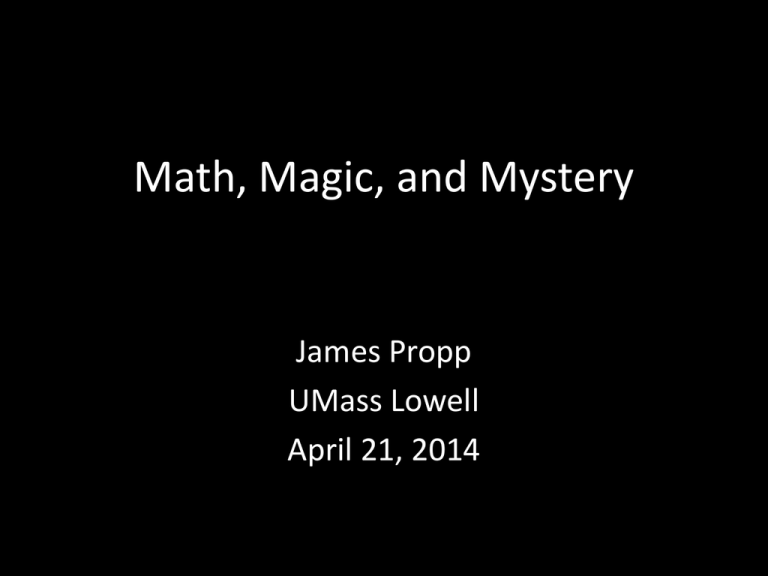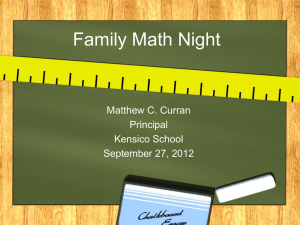Math, Magic, and Mystery
advertisement

Math, Magic, and Mystery James Propp UMass Lowell April 21, 2014 Mathematics Awareness Month This year’s theme is “Mathematics, Magic, and Mystery” (not coincidentally also the title of a book by Martin Gardner). Visit mathaware.org for new daily links to interesting mathematical content throughout April 2014. • Stage magic vs. real magic • Wonder vs. understanding MATH Two big changes in the past 200 years: • Method • Matter Method • New standards of rigor • Rigor and intuition • Bolzano’s revolution a quote from Paul Halmos “The day when the light dawned ... I suddenly understood epsilons and limits, it was all clear, it was all beautiful, it was all exciting. … It all clicked and fell into place. I still had everything in the world to learn, but nothing was going to stop me from learning it. I just knew I could. I had become a mathematician.” Subject matter • Higher-dimensional Euclidean geometries • Non-Euclidean geometries From universe to multiverse Matter • • • • Higher-dimensional Euclidean geometries Non-Euclidean geometries Strange number-systems … Matter • • • • Higher-dimensional Euclidean geometries Non-Euclidean geometries Strange number-systems … Result: The liberation of math from reality (or should I say “from merely physical reality”) The end result Tools of the mind that were created to help us understand this world have been repurposed as tools for transcending it. a quote from J. J. Thomson “In fact, the pure mathematician may create universes just by writing down an equation, and indeed if he is an individualist he can have a universe of his own.” MAGIC • Half Magic, by Edward Eager • The Magicians, by Lev Grossman • The Name of the Wind, by Patrick Rothfuss from Half Magic “The trouble with life is that not enough impossible things happen for us to believe in.” from The Magicians “A lot of the test was calculus, pretty basic stuff for Quentin.” from The Magicians “Quentin's other homework ... turned out to be a thin, large-format volume containing a series of hideously complex finger and voice-exercises arranged in order of increasing difficulty and painfulness. Much of spellcasting, Quentin gathered, consisted of very precise hand gestures accompanied by incantations to be spoken or chanted or whispered or yelled or sung. Any slight error in the movement or in the incantation would weaken, or negate, or pervert the spell.” A typical definition The limit of f(x) as x approaches a equals L if and only if for every ε > 0 there exists δ > 0 such that every real number satisfying 0 < |x - a| < δ satisfies |f(x) – L| < ε . (note use of symbols from an ancient language!) A typical finger-exercise • Show: The limit of 2x as x approaches a is 2a. • Proof: Given ε > 0 , let δ = ε/2; then for every x satisfying 0 < |x - a| < δ we have |2x – 2a| = 2|x - a| < 2δ = ε, so |2x – 2a| < ε, as claimed. (note summoning of ε/2 and binding of δ!) Separation of worlds • Earth, Narnia, Charn, … (C.S. Lewis) • Earth, Fillory, … (Lev Grossman) • Geometry, statistics, number theory, … Bridges between worlds • The Wood between the Worlds (C.S. Lewis) • The Neitherlands (Lev Grossman) • Some mysterious glue that holds math together and keeps it from splitting into unrelated specialties a tale from Eugene Wigner There is a story about two friends, who were classmates in high school, talking about their jobs. One of them became a statistician and was working on population trends. He showed a reprint to his former classmate. The reprint started, as usual, with the Gaussian distribution and the statistician explained to his former classmate the meaning of the symbols for the actual population, for the average population, and so on. (continued on next slide) a tale from Eugene Wigner (continued) His classmate was a bit incredulous and was not quite sure whether the statistician was pulling his leg. "How can you know that?" was his query. "And what is this symbol here?" "Oh," said the statistician, "this is pi." "What is that?" "The ratio of the circumference of the circle to its diameter." "Well, now you are pushing your joke too far," said the classmate, "surely the population has nothing to do with the circumference of the circle." What is magic good for? • • • • • • • • • • 1. Wealth 2. Love 3. Invisibility 4. Power 5. Flight 6. Life 7. Time travel 8. Other worlds 9. Transformation 10. Harmony 1. Wealth 1. Wealth Begs the question: what would you use it for? 2. Love 2. Love Sorry, wrong profession. 3. Invisibility 3. Invisibility Cloaking? (But that’s applied math; I’m more interested in the multiverse of pure math.) 4. Power 4. Power What if you could do an infinite amount of work with a finite amount of effort? A theorem For every positive integer n, 1 + 2 + 3 + … + n = n(n+1)/2. That is: • • • • • • 1 = (1)(2)/2 1 + 2 = (2)(3)/2 1 + 2 + 3 = (3)(4)/2 1 + 2 + 3 + 4 = (4)(5)/2 1 + 2 + 3 + 4 + 5 = (5)(6)/2 … Infinitely many things to prove! The magic wand Proof by induction: “Knock over the first domino, and the rest got knocked down automatically.” But who set up the dominos? How are our finite human minds able to master (aspects of) infinity? 5. Flight 5. Flight Check out https://www.youtube.com/watch?v=tPlPnTev14s (Your generation will make such fly-overs interactive.) 5. Flight Check out https://www.youtube.com/watch?v=tPlPnTev14s The opposite of flying is burrowing, which can be magical too… a quote from Galileo “The Book of Nature is written in the language of mathematics.” 6. Life 6. Life Would you really want to live FOREVER? What would that even be like? I think living five or six generations would probably be enough for me. In the world of math research, we get to do this! 7. Time travel A bogus proof • Show: The limit of 2x as x approaches a is 2a. • Proof: Given ε > 0 , let δ = ε; then for every x satisfying 0 < |x - a| < δ we have |2x – 2a| = 2|x - a| < 2ε, so |2x – 2a| < 2ε, so, um... Now that we see what went wrong, we can go back in time and fix it. 8. Other worlds 8. Other worlds • Weird geometries • Weird number systems • Other weirdness 9. Transformation Example: Sleator-Tarjan-Thurston In our construction we go through a series of reductions from one problem to another. The solution to the last problem gives us our answer. Pair of trees with large rotation distance 1 Pair of polygon triangulations with large flip distance 2 Polyhedra requiring many tetrahedra 3 Hyperbolic polyhedra with large volume Example: everting a sphere See https://www.youtube.com/watch?v=wO61D9x6lNY from the movie “Outside In” Example: Banach-Tarski paradox See https://www.youtube.com/watch?v=m4YDNHvAfeU By sliding the orange region (in the hyperbolic plane) appropriately, we can transmute it from one-third of the space to one-half of the space. 10. Harmony 10. Harmony Usual ways to resolve disagreements are to retreat into mysticism (“You’re right and you’re right too, for all is one”) or disengagement (“Let’s agree to disagree”). The mathematical multiverse offers something more interesting. Rigorous relativism Every non-Euclidean space can be imbedded in a Euclidean space of higher dimension, and vice versa. Rather than being mutually contradictory, the different geometries are mutually supporting. “Gabriel’s horn” MYSTERY The unreasonable effectiveness of applied mathematics The unreasonable effectiveness of applied mathematics Our universe our brains our math our universe The unreasonable relevance of pure mathematics The unreasonable relevance of pure mathematics E.g.: Why should complex numbers (invented for no very compelling reason by Italian algebraists in the Renaissance) describe electromagnetism? a quote from Gian-Carlo Rota “Of all escapes from reality, mathematics is the most successful ever. It is a fantasy that becomes all the more addictive because it works back to improve the same reality we are trying to evade.” The unreasonable tractability of mathematics The unreasonable tractability of mathematics “Who arranged those dominos?” Or rather: “Why are they so close together if nobody put them that way with our wishes in mind?” The unreasonable interestingness of mathematics The unreasonable interestingness of mathematics How can we possibly be surprised by the consequences of rules that we ourselves have chosen? from The Name of the Wind “He also taught me a game called Seek the Stone. The point of the game was to have one part of your mind hide an imaginary stone in an imaginary room. Then you had another, separate part of your mind try to find it.” Why should math be so generative of theorem after surprising theorem, when all we put into it is a handful of axioms and definitions? Why should it appear to give us back more than we put into it? Is this last mystery temporary? Maybe human math is interesting to humans because our brains are broken. Maybe as we as a species get better at math, it'll become more boring. But we're nowhere near that point yet. For the past hundred years, mathematical history has been at the exact point where C.S. Lewis took his leave of Narnia: from The Last Battle “All their life in this world and all their adventures in Narnia had only been the cover and the title page: now at last they were beginning Chapter One of the Great Story which no one on earth has read: which goes on forever: in which every chapter is better than the one before.” And so… “Further up and further in!” I hope some of you will join the adventure. Thank you for listening!







